Solved Examples and Worksheet for Constructing Line Plots
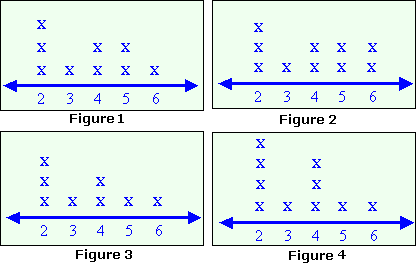
A. Figure 1
B. Figure 2
C. Figure 3
D. Figure 4
Step: 1
On a line plot, the number of times a data value occurs in a data set is indicated by cross marks above that value on a number line.
Step: 2
Arranging the data in the ascending order, the sequence becomes
2, 2, 2, 3, 4, 4, 5, 5, 6.
Step: 3
The line plot is obtained by labeling all unique data values on the line and representing the number of times a data value is repeated in the form of cross marks.
Step: 4
The line plot given in Figure 1, represents the data correctly.
[The number of occurrences of each data value match with the number of cross marks.]
Correct Answer is : Figure 1
| Number | Frequency |
| 1 | 2 |
| 2 | 3 |
| 3 | 3 |
| 4 | 2 |
| 5 | 4 |
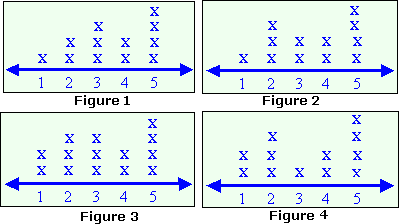
A. Figure 1
B. Figure 2
C. Figure 3
D. Figure 4
Step: 1
The line plot is a representation of the data on a number line, where each unique data value is a point on the line and the number of times it occurs in the set is indicated by crosses over its position on the number line.
Step: 2
From the frequency table, a list of the unique data values can be obtained and the frequency column gives the number of times each value occurs in the data set.
Step: 3
Plot this data with numbers 1-5 on the number line. Put the number of crosses over the values to indicate frequency / repeated occurrence.
Step: 4
Observing the choices, the number of occurrences of each data value match with the number of cross symbols in the Figure 3.
Step: 5
So, the line plot given in Figure 3 is the correct plot for this data.
Correct Answer is : Figure 3
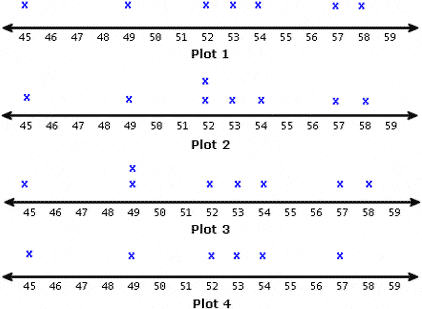
A. Plot 1
B. Plot 2
C. Plot 3
D. Plot 4
Step: 1
On a line plot, the number of times a data value occurs in a data set is indicated by cross marks above that value on a number line.
Step: 2
Arranging the data in the ascending order, the sequence becomes 45, 49, 49, 52, 53, 54, 57, 58.
Step: 3
The line plot is obtained by labeling all unique data values on the line and representing the number of times a data value is repeated in the form of cross marks.
Step: 4
Plot 3 is the correct representation of the data.
[The number of occurrences of each data value match with the number of cross marks.]
Correct Answer is : Plot 3
| Age | Number of children |
| 14 | 9 |
| 15 | 7 |
| 16 | 4 |
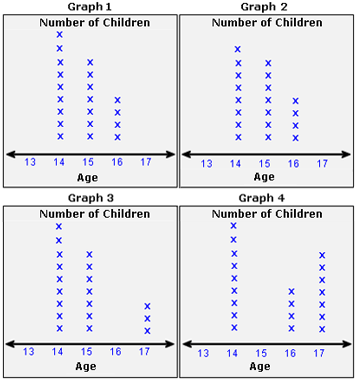
A. Graph 1
B. Graph 2
C. Graph 3
D. Graph 4
Step: 1
To make a line plot, list the ages of the children in the table below a horizontal line.
Step: 2
Represent the number of children in same age as the number of cross marks above the corresponding age.
Step: 3
Observing all the line plots, the number of cross marks in line plot in Graph-1 match with the data given in the table.
Step: 4
So, the line plot in Graph-1 is the appropriate representation of the data given in the table.
Correct Answer is : Graph 1
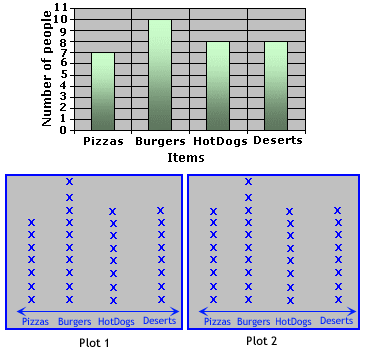
A. Plot 1
B. Plot 2
Step: 1
The height of each bar in the bar graph indicates the number of people who eat the corresponding food items.
Step: 2
To make a line plot, list the names of the food items in the bar graph, below a horizontal line.
Step: 3
Represent the number of persons who eat each food item as the number of cross marks above the corresponding food item.
Step: 4
Observing all the line plots, the number of cross marks in line plot in Plot-1 match with the data shown in the bar graph
Step: 5
So, plot 1 is the correct choice.
Correct Answer is : Plot 1
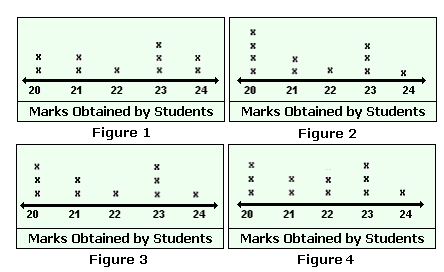
A. Figure 1
B. Figure 2
C. Figure 3
D. Figure 4
Step: 1
20,20,20,21,21,22,22,23,23,23 and 24.
[Original data set.]
Step: 2
The number of times 20 occurred in the set = 3.
Step: 3
The number of times 21 occurred in the set = 2.
Step: 4
The number of times 22 occurred in the set = 2.
Step: 5
The number of times 23 occurred in the set = 3.
Step: 6
The number of times 24 occurred in the set = 1.
Step: 7
In a line plot, the number of times a data value occurs in the data set is indicated by cross marks above the respective data value on the number line.
Step: 8
Comparing the steps above with the line plots, we notice that Figure 4 is the correct choice.
Correct Answer is : Figure 4
Scores obtained are 20, 20, 20, 21, 21, 22, 23, 23, 23, and 24.
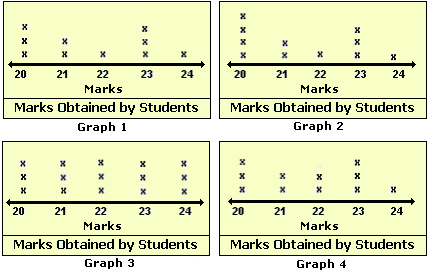
A. Graph 2
B. Graph 1
C. Graph 3
D. Graph 4
Step: 1
20, 20, 20, 21, 21, 22, 23, 23, 23, and 24.
[Original data set.]
Step: 2
The number of times 20 occurred in the set = 3.
Step: 3
The number of times 21 occurred in the set = 2.
Step: 4
The number of times 22 occurred in the set = 1.
Step: 5
The number of times 23 occurred in the set = 3.
Step: 6
The number of times 24 occurred in the set = 1.
Step: 7
The number of times data value occurred in data is indicated by cross marks above the value on a number line.
Step: 8
By comparing the above steps by the line plots, Graph 1 is the appropriate line plot.
Correct Answer is : Graph 1

A. Plot 1
B. Plot 2
C. Plot 3
D. Plot 4
Step: 1
In a line plot, the number of times a data value occurs in a data set is indicated by cross marks above that value on the number line.
Step: 2
So, Plot 3 is the correct representation of the data.
[The number of occurrences of each data value match with the number of cross symbols.]
Correct Answer is : Plot 3
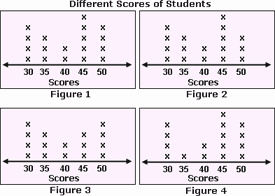
A. Figure 1
B. Figure 3
C. Figure 2
D. Figure 4
Step: 1
30, 30, 30, 30, 35, 35, 35, 40, 40, 45, 45, 45, 45, 45, 50, 50, and 50.
[Original data set.]
Step: 2
The number of times 30 occurred in the set = 4 times.
Step: 3
The number of times 35 occurred in the set = 3 times.
Step: 4
The number of times 40 occurred in the set = 2 times.
Step: 5
The number of times 45 occurred in the set = 5 times.
Step: 6
The number of times 50 occurred in the set = 3 times.
Step: 7
The number of times data value occurred in data is indicated by cross marks above the value on a number line.
Step: 8
By comparing the above steps by the line plots, Figure 2 is an appropriate line plot.
Correct Answer is : Figure 2
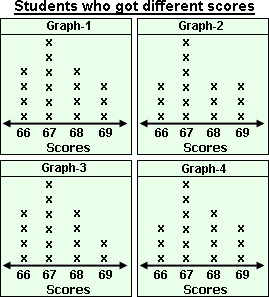
A. Graph 4
B. Graph 3
C. Graph 1
D. Graph 2
Step: 1
66, 69, 67, 68, 66, 67, 66, 67, 67, 66, 68, 69, 67, 67, 68, 69 and 68.
[Original data set.]
Step: 2
The number of times a data value occurred in data is indicated by cross marks above the value on a number line.
Step: 3
The number of times 66 occurred in the set = 4.
Step: 4
The number of times 67 occurred in the set = 6.
Step: 5
The number of times 68 occurred in the set = 4.
Step: 6
The number of times 69 occurred in the set = 3.
Step: 7
By comparing the above values with the line plots, Graph 1 is the appropriate line plot.
Correct Answer is : Graph 1
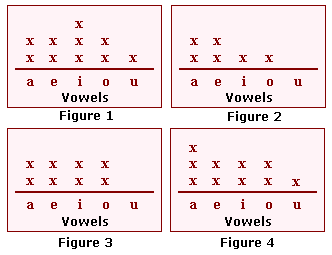
A. Figure 3
B. Figure 1
C. Figure 4
D. Figure 2
Step: 1
The vowels in the English alphabets are a e i o u
Step: 2
To make the line plot, represent the vowels under a horizontal line.
Step: 3
The number of a e i o u
Step: 4
Mark the occurrences of each vowel as cross marks above the corresponding vowel.
Step: 5
Observing the line plots, the plot in Figure 2 is the appropriate plot for the number of vowels in the sentence.
[The number of cross marks exactly match the number of different vowels.]
Correct Answer is : Figure 2
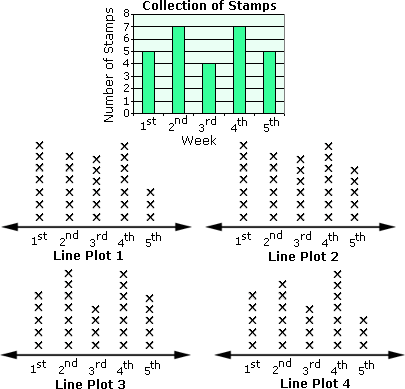
A. Line Plot 1
B. Line Plot 2
C. Line Plot 4
D. Line Plot 3
Step: 1
Interpret the data shown on the bar graph in a table as shown.
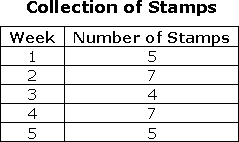

Step: 2
Now, match the data on the table with each graph shown.
Step: 3
Only Line Plot 3 correctly matches the data.
Correct Answer is : Line Plot 3
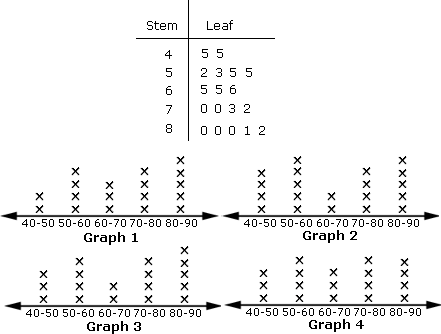
A. Graph 2
B. Graph 3
C. Graph 4
D. Graph 1
Step: 1
Match the data shown on the stem-and-leaf plot with each line plot shown.
[Compare the number of cross marks above each range of scores on the line plot with the number of entries against the respective range on the stem-and-leaf plot.]
Step: 2
Only Graph 1 correctly matches the data.
Correct Answer is : Graph 1
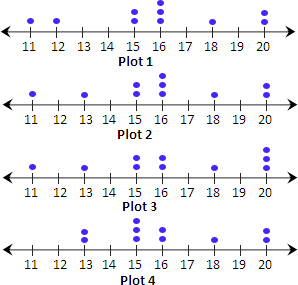
A. Plot 1
B. Plot 3
C. Plot 4
D. Plot 2
Step: 1
Given data set in ascending order is 11, 13, 15, 15, 16, 16, 16, 18, 20, 20.
Step: 2
The number of times 11 has occurred in the data = 1
The number of times 13 has occurred in the data = 1
The number of times 15 has occurred in the data = 2
The number of times 16 has occurred in the data = 3
The number of times 18 has occurred in the data = 1
The number of times 20 has occurred in the data = 2
The number of times 13 has occurred in the data = 1
The number of times 15 has occurred in the data = 2
The number of times 16 has occurred in the data = 3
The number of times 18 has occurred in the data = 1
The number of times 20 has occurred in the data = 2
Step: 3
In a dot plot, the number of times the data has occurred is represented by dots above the respective data over a number line.
Step: 4
Comparing the above steps with the given dot plots, we see that Plot 2 represents the given data correctly.
Correct Answer is : Plot 2
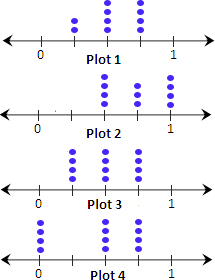
A. Plot 2
B. Plot 3
C. Plot 1
D. Plot 4
Step: 1
In a dot plot, the number of times the data has occurred is represented by dots above the respective data over a number line.
Step: 2
Number of 1 4
Step: 3
Number of 1 2
Step: 4
Number of 3 4
Step: 5
Comparing the above steps with the given dot plots, we see that Plot 3 represents the given data correctly
Correct Answer is : Plot 3
- Writing Quadratic Equations for Line of Fit-Algebra1-Solved Examples
- Constructing Histograms-Algebra1-Solved Examples
- Constructing Box-and-Whisker Plots-Algebra1-Solved Examples
- Reading and Interpreting Scatter plots-Algebra1-Solved Examples
- Constructing Scatter Plots and Line of Fit-Algebra1-Solved Examples
- Comparing Two Related Sets of Data and Expected Value-Algebra1-Solved Examples
- Identifying Outliers-Algebra1-Solved Examples
- Comparing Linear, Quadratic and Exponential Models-Algebra1-Solved Examples
- Correlation Coefficient, Causation and Correlation-Algebra1-Solved Examples
- Meaning of Slope and Intercepts in Graphs and Situations-Algebra1-Solved Examples
Related Worksheet
- Data